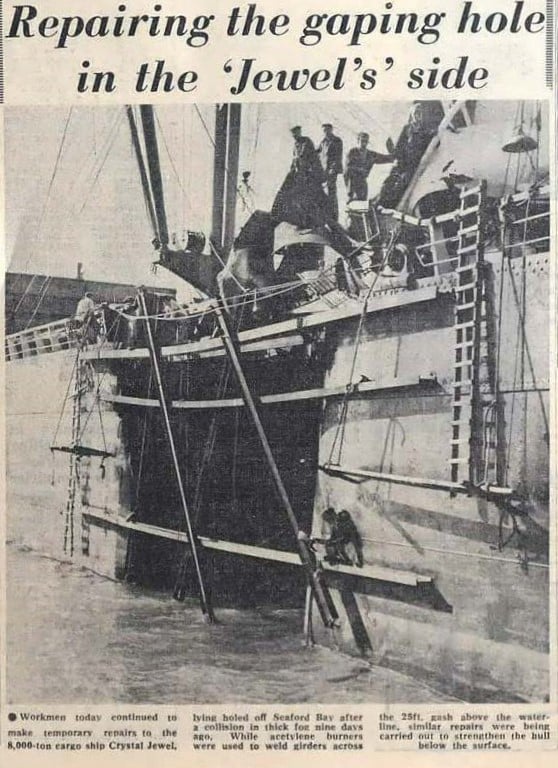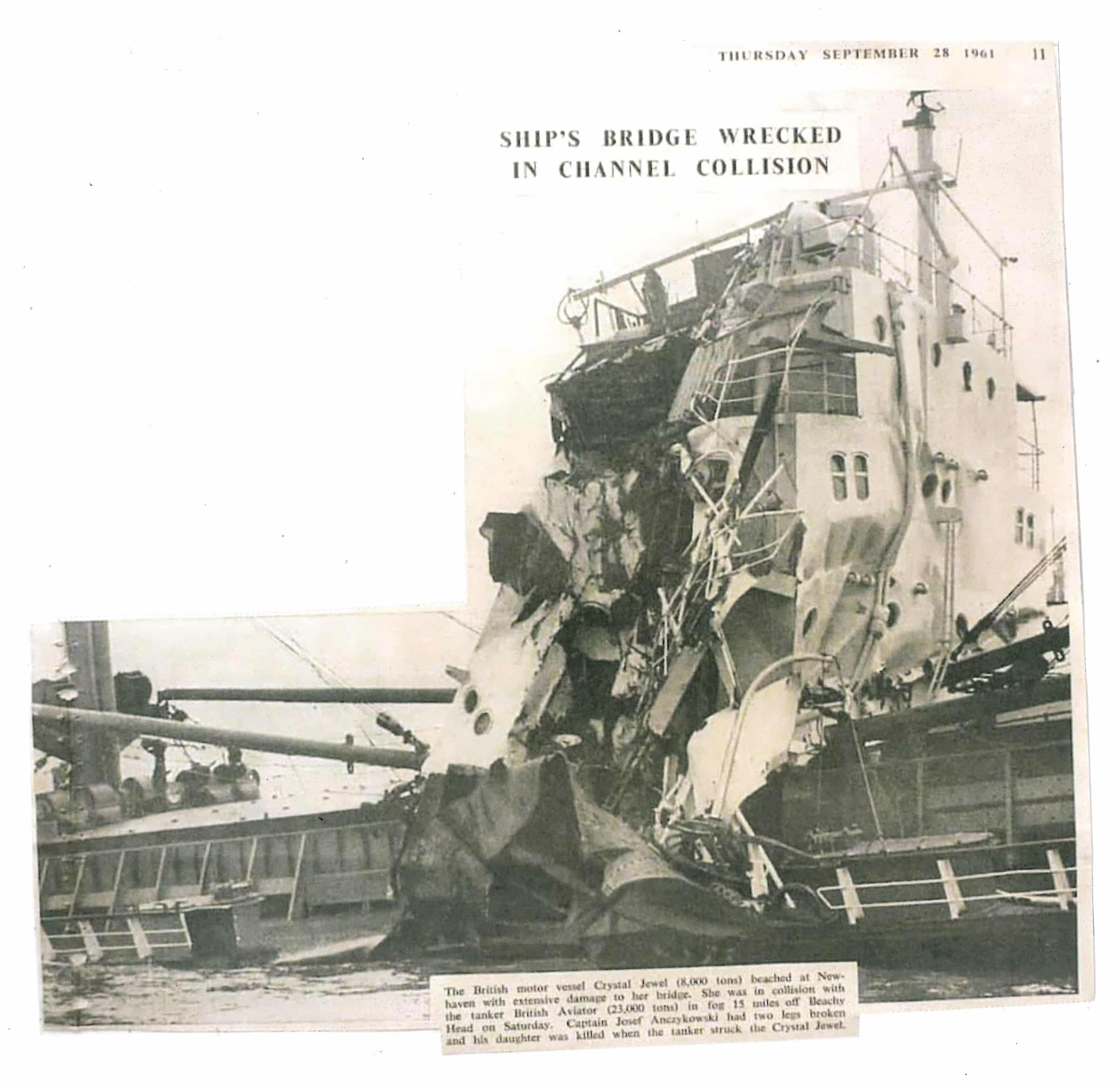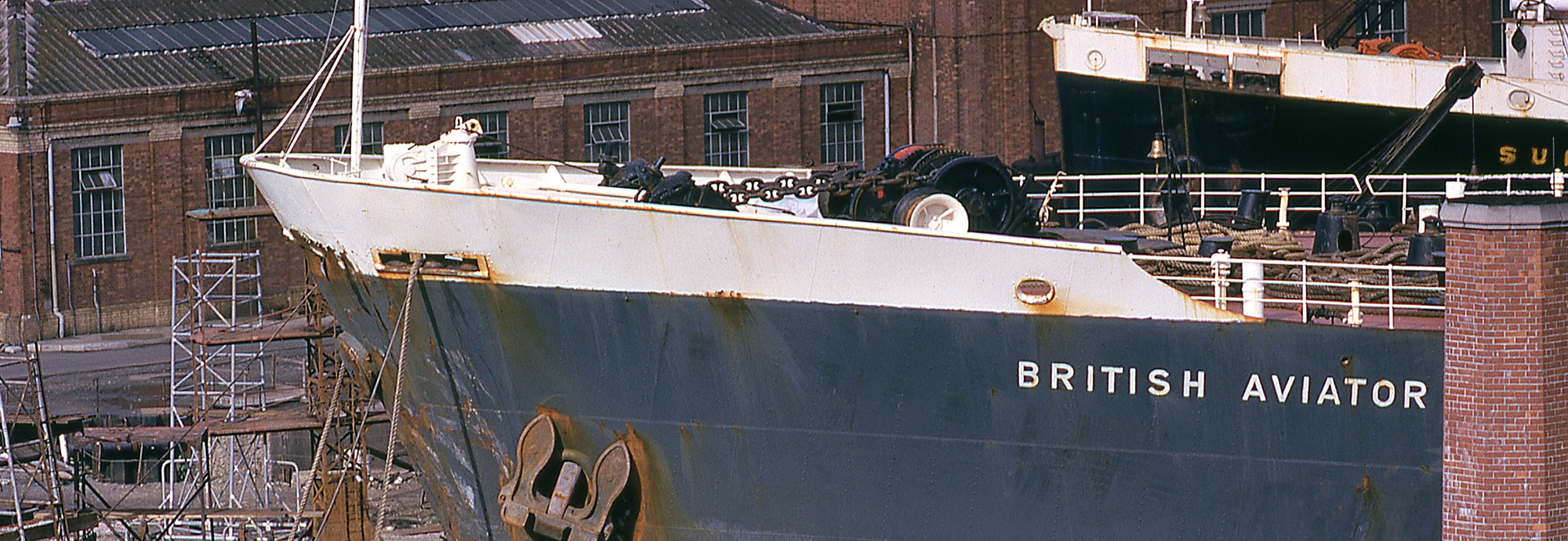By Lynne Vosper and Linda Batchelor
An image from National Maritime Museum Cornwall’s photographic archive, the related research and a connection with Falmouth has inspired this latest Bartlett Blog.
A Radar Assisted Collision at Sea
On 23 September 1961 the BP Tanker British Aviator was in collision in the English Channel with Crystal Jewel a British Bulker owned by the Athel Line. Both ships were badly damaged in what was the first, and is now said to be a classic example of a ‘radar assisted’ collision at sea.
Repairs in Falmouth Docks

British Petroleum Oil Tanker British Aviator in No. 3 Dry Dock at Falmouth Docks during October 1961 with collision damage to the bow, taken from Castle Drive. © National Maritime Museum Cornwall
This dramatic photograph of British Aviator in Dry Dock at Falmouth Docks shows the collision damage to the bow and is taken from the Weller Photographic Collection. The Collection is a comprehensive record of shipping and craft mostly taken in and around Falmouth Harbour and Falmouth Docks over a 36-year period from 1933 to 1969 by David John Weller and his son David. Given to the Museum in 2004 in memory of David John and Eleanor Winifred Weller, the Collection has been researched and catalogued.
The damage to Crystal Jewel was extensive, including wreckage of the ship’s bridge and a gaping hole in the ship’s side, as shown by the newspaper cuttings below. The Captain Josef Anczykowski suffered two broken legs as a result of the collision and sadly his 14-year-old daughter was killed when the ship was struck by British Aviator.

Workmen making temporary repairs to the Crystal Jewel cargo ship, lying holed off Seaford Bay after the collision in thick fog. While acetylene burners were used to weld girders across the 25ft gash above the waterline, similar repairs were being carried out to strengthen the hull below the surface.

Crystal Jewel beached at Newhaven with the damage to the bridge after the collision.
The Two Ships
British Aviator was a 23,124 ton Steam Tanker built by Swan, Hunter & Wigham Richardson Ltd at Wallsend for BP Tanker Co Ltd. The tanker was launched on 23 December 1957 and completed on 29 October 1958. The ship was 655.9 feet in length and 86.5 feet in the beam. She was fitted with a geared turbine engine of 14,000 shaft horsepower with a full speed of about 16 knots. At the time of the collision British Aviator was on route from Wilhelmshaven for Mina al Almadi.
British Aviator was a much bigger vessel than Crystal Jewel which was built at Smith’s Dock in Middlesborough in 1956 for Sugar Line Ltd as a bulk carrier. The ship was a 8671 ton, single screw vessel with a length of 442.2 feet and a beam of 61.25 feet and was fitted with a direct acting internal combustion engine of 3,300 brake horsepower. Crystal Jewel was carrying a full cargo of grain from Duluth to Rotterdam.
The Collision
The two ships collided at 0851 hours (British Summer Time) on 23 September 1961 in the English Channel. The position was approximately eight miles south east of the Royal Sovereign Light Vessel and the weather at the time was dense fog with visibility of about 300 to 400 feet with a light wind.
Both vessels had been sounding their whistles with long blasts for fog at proper intervals and as they drew closer they could each hear the signals of the other. Both vessels were proceeding with their engines working at half speed ahead and were also using radar. Evidence shows that in each case the echo of the other vessel was observed at extreme range which was about ten miles or half an hour at the speed at which they were travelling. During that time they had notice of one another and the radar echoes showed that the vessels would pass all clear starboard-to-starboard.
However, a series of faulty manoeuvres undertaken by the crews of both vessels on the strength of defective radar observations led to a very different situation and to the course which caused the disastrous collision resulting in the loss of a life, serious personal injury and major damage to the ships. The stem of British Aviator penetrated twenty feet into the bridge and accommodation of the Crystal Jewel, where the fatality occurred, and which because of the extensive damage, was sinking. Thirty of the crew and the injured master were taken on board British Aviator.
Times Atlas and Encyclopaedia of the Sea
The Coastguard were informed and just after ten o’clock the tugs Meeching, with a doctor on board, and Tidworth put out from Newhaven and the Eastbourne lifeboat Beryl Tollemarche also put out with a doctor on board. The tug Meeching reached the scene first and took the sinking Crystal Jewel in tow whilst the crew, her injured master and his daughter were transferred to the lifeboat and landed at Eastbourne. The fog persisted throughout the day and to guide the lifeboat ashore on return maroons were fired at five minute intervals.
The tugs towed Crystal Jewel into Seaford Bay, Newhaven for extensive repairs and following the collision British Aviator sailed to Falmouth. The Falmouth Harbour Master’s Journal No.38 held in the Museum’s Bartlett Library states that British Aviator arrived in Falmouth Docks on 24 September for survey to damage. A newspaper cutting book for the Docks for 1960-61 advises that “the 23,124 ton British Petroleum tanker British Aviator was berthed alongside the Eastern Wharf yesterday and is expected to move into the Queen Elizabeth Dry Dock today for repairs to her bows which were damaged in last Saturday’s Channel collision with the Crystal Jewel (8,671 tons)”. The Harbour Master’s Journal confirms that the ship sailed for Mena al Almadi on 30 October 1961.
The Legal Consequences
Rule 16 of the International Regulations for Preventing Collisions at Sea states “Every vessel which is directed to keep out of the way of another vessel, shall so far as possible, take early and substantial action to keep well clear”. This rule was not observed in the case of the British Aviator and the Crystal Jewel despite the use of radar which unfortunately was misused by both vessels and set them instead on a collision course. As Lord Justice Willmer stated in his judgement in the subsequent appeal case “instead of being a valuable aid to navigation, as it should be, it becomes a positive source of danger” and he called upon those concerned with shipping, particularly masters and navigating officers, to take the utmost care when navigating clear passage using radar to ensure its proper deployment.
The collision of the two vessels in this case was first the subject of a formal investigation by the Department of Trade. This took place in London on 19 and 20 February 1962 and concluded that both vessels were to blame and suspended both masters for a period of twelve months.
An action for damages was brought by the owners of Crystal Jewel against the owners of British Aviator in the Admiralty Court on 5 and 6 October 1964. The judge Mr Justice Cairns apportioned blame as two fifths to Crystal Jewel and three fifths to British Aviator. The owners of British Aviator then appealed asking only that the blame be equally shared, although if granted so great was the damage to both vessels that this “seemingly trivial alteration” would make a difference of £60,000 to them.
The appeal was heard by the Court of Appeal on 3 March 1965 between The Owners of the Motor Vessel Crystal Jewel, Plaintiffs and The owners of the Steam Tankship British Aviator, Defendants. The case was heard before Lord Justice Sellers, Lord Justice Willmer and Lord Justice Winn. The judges concluded that on the facts of the case there was never any real doubt that both vessels were seriously to blame and that liability should be apportioned equally. Leave to appeal to the House of Lords was refused.
The judges also made it clear in their judgements that it was a collision which should never have happened and would not have done so if radar had not been misused. They hoped that publicity would draw attention to the real and urgent problem of the misuse of radar in such cases. A hope that was subsequently fulfilled with greater regulation on training and deployment of radar and the introduction of schemes such as the International Maritime Organization’s Traffic Separation Scheme (TSS) which regulates the flow of vessels in areas of heavy traffic at sea.
This was truly a case of a ‘radar assisted collision’ and this judgement was a major step forward in ensuring the correct use of radar to enhance safety at sea.
The Bartlett Blog
The Bartlett Blog is written and produced by the volunteers who staff The Bartlett Maritime Research Centre and Library of National Maritime Museum Cornwall. The British Aviator and the Crystal Jewell was written by Lynne Vosper and Linda Batchelor.
The Bartlett Library holds a Collection of over 20,000 volumes and offers access to one of the finest collections of maritime reference books, periodicals and archival material. The Bartlett Blog reflects the diversity of material available in The Bartlett Library.



